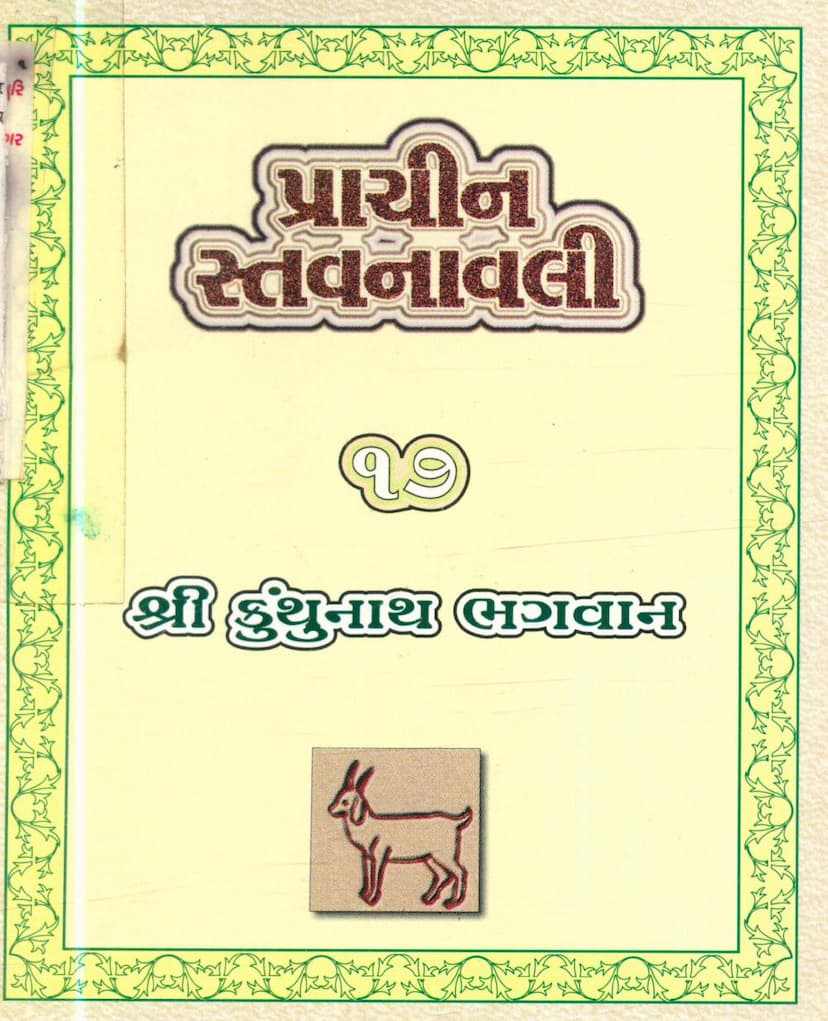Prachin Stavanavli 17 Kunthunath
Added to library: September 2, 2025

Summary
Here's a comprehensive summary of the provided Jain text, "Prachin Stavanavli 17 Kunthunath," authored by Hasmukhbhai Chudgar:
Title: Prachin Stavanavli 17 Kunthunath (Collection of Ancient Hymns dedicated to the 17th Tirthankara, Kunthunath)
Author: Hasmukhbhai Chudgar
Publisher: Hasmukhbhai Chudgar
Catalog Link: https://jainqq.org/explore/032240/1
Overall Purpose: This booklet is a compilation of ancient hymns and devotional songs (stanzas) dedicated to Lord Kunthunath, the 17th Tirthankara in Jainism. The primary aim is to facilitate spiritual upliftment and self-realization through devotion (bhakti) to the Tirthankara. The author, Hasmukhbhai Chudgar, has collected these hymns, many of which are ancient and previously difficult to access, to provide a resource for followers to deepen their connection with the divine.
Key Themes and Content:
-
Devotion to Tirthankaras: The core message of the book is the importance of Paramatma Bhakti (devotion to the Supreme Soul/Tirthankara). It emphasizes that through sincere devotion, an individual can transcend worldly existence and achieve the state of the Supreme Soul. The compilation includes hymns dedicated specifically to Lord Kunthunath, highlighting his virtues and spiritual significance.
-
Navkar Mantra: The booklet begins with a hymn praising the Navkar Mantra (the fundamental chant in Jainism). It describes the mantra as the essence of the fourteen Purvas (ancient Jain scriptures), infinite in meaning, and to be chanted at all times, in all circumstances, by all beings. The mantra is presented as a source of power and a means to overcome suffering and attain liberation.
-
Lord Kunthunath: The book focuses on Lord Kunthunath, detailing aspects of his life and virtues:
- Parentage and Birth: His father was King Sura, and his mother was Queen Shrimati. He was born in Gajpur city.
- Life Events: The text mentions his life span (95,000 years), his physical stature (35 Dhanush), his golden complexion, his renunciation at the age of 16 after a period of 16 years as a householder, and his attainment of Kevala Jnana (omniscience). His diksha (initiation) took place on the 5th day of Vaishakh month.
- Lakhana (Symbol): His symbol is a goat.
- Samavasarana: The text describes his presence in the Samavasarana (the divine assembly hall where Tirthankaras preach).
- Liberation: He attained Moksha (liberation) from Sammet Shikhar.
- His Virtues: The hymns praise his compassion, his ability to fulfill desires, his detachment from worldly pleasures, his knowledge, his equanimity, and his role as a guide to liberation.
-
Compilation of Stanzas (Stavans): A significant portion of the book comprises various stanzas composed by different esteemed Jain scholars and monks. These hymns are presented with their respective authors, indicating a rich tradition of devotional literature. Examples include:
- Hymns by Shri Anandghanji, Upadhyaya Yashovijayji, Shri Bhanvijayji, Shri Anandvardhanji, and many others.
- Each hymn offers a unique perspective and expression of devotion towards Lord Kunthunath, often employing poetic metaphors and devotional language.
-
Chaitra Vandana (Temple Worship): The booklet also includes the Chaitra Vandana Vidhi, which outlines the ritualistic steps and prayers to be recited during temple worship. This section includes:
- Basic Prayers: Such as "Ichchhami khamāsamano sutra" and "Iriyavahiyam sutra" (prayers for repentance and purification).
- Lougass (Loggassa) Sutra: A hymn of praise for all 24 Tirthankaras.
- Concluding Prayers: Including "Junkinchi cheiyai," "Namuththun Sutra," and "Javant Cheiyai" (prayers to all Jinabimbas and Jain monks/nuns).
- The intention is to guide the devotee through the prescribed rituals for honoring the Tirthankara in the temple.
-
Spiritual Guidance: The introductory and concluding remarks by Acharya Vijay Ramsurishwarji Maharaj and Jagachchandra Suri, respectively, provide philosophical context. They emphasize that true devotion comes from understanding the Tirthankara and not just performing rituals mechanically. They highlight that even a few tears shed in devotion can surpass years of worldly tears, leading towards spiritual liberation.
-
Structure and Format: The book is organized into sections, with a table of contents (Antarmalika) listing the hymns and their page numbers. This makes it easy for users to navigate and find specific devotional songs.
Significance: "Prachin Stavanavli 17 Kunthunath" serves as a valuable resource for Jain devotees interested in the life and teachings of Lord Kunthunath. It preserves and disseminates ancient devotional literature, fostering a deeper connection with the spiritual heritage of Jainism. The compilation encourages sincere devotion as a path to overcoming karma and achieving ultimate liberation (Moksha).
In essence, this book is a spiritual guide and a treasure trove of devotional poetry dedicated to Lord Kunthunath, promoting the principles of sincere devotion, adherence to Jain rituals, and the ultimate goal of spiritual liberation.